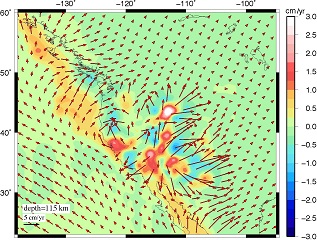The forces that cause deformation of western North America have been debated for decades. Recent studies, primarily based on analysis of crustal stresses in the western United States, have suggested that the deformation of the region is mainly controlled by gravitational potential energy (GPE) variations and boundary loads, with basal tractions due to mantle flow playing a relatively minor role. Gosh et al. (2013) address these issues by modelling the deviatoric stress field over western North America from a 3-D finite element mantle circulation model, CitcomS, with lateral viscosity variations, using the latest tomography available for the region. They solve the equations for instantaneous, incompressible fluid flow with infinite Prandtl number, where flow is driven by mantle density anomalies (Boussinesq approximation). Their approach takes into account the contribution from both topography and shallow lithosphere structure (GPE variations that we apply as stress boundary condition) as well as that from deeper mantle flow in one single model, as opposed to separate lithosphere and circulation models, as has been done so far. In addition to predicting the deviatoric stresses, they also jointly fit the constraints of geoid, dynamic topography and plate motion both globally and over North America, in order to ensure that the forces that arise in our models are dynamically consistent. They use a resolution of ~0.75 × 0.75° for majority of the runs, although for the final models, they use a higher resolution of ~0.25 × 0.25°. They argue that although GPE variations control a large part of the deformation of the western United States, deeper mantle tractions also play a significant role. For the full article see: 10.1093/gji/ggt151.

Horizontal velocity plotted on top of radial flow underneath western North America from nested tomography model SH_TX2008 (Schmandt & Humphreys, 2010). Small scale convection can be seen at shallow depths.
